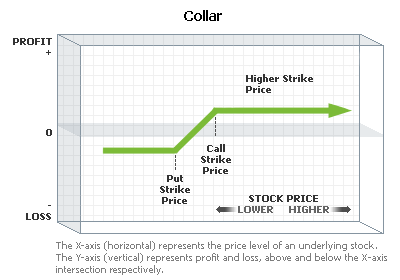 From the Options Industry Council:
From the Options Industry Council:
The results of a new study examining the use of options in a collar strategy (both active and passive implementations) on the PowerShares QQQ™ exchange-traded fund (ETF) show it provides superior returns to the traditional buy and hold strategy while reducing risk by almost 65%.
The Options Industry Council (OIC) is pleased to note the study reaffirms the risk management potential of equity options, finding that during the entire 10-year study period, including the sub-periods around the tech bubble and credit crisis, collars significantly outperformed the QQQ, providing much needed capital protection.
 “Loosening Your Collar: Alternative Implementations of QQQ Collars,” by Edward Szado and Thomas Schneeweis, looked at data from March 1999 to May 2009. It concluded that over the entire 122 month period the passive collar returned almost 150%, while the QQQ lost one-third of its value. The active collar outperformed both strategies and returned more than 200%.
“Loosening Your Collar: Alternative Implementations of QQQ Collars,” by Edward Szado and Thomas Schneeweis, looked at data from March 1999 to May 2009. It concluded that over the entire 122 month period the passive collar returned almost 150%, while the QQQ lost one-third of its value. The active collar outperformed both strategies and returned more than 200%.
Additionally, the study simulated a collar on a small-cap mutual fund. The return of the active mutual fund collar was four times the return of the fund, while the standard deviation was about one-third lower. The study was conducted by the Isenberg School of Management’s Center for International Securities and Derivatives Markets (CISDM) at the University of Massachusetts.
Typically, you want to employ a collar to protect a dividend-paying stock from losing value. We employed this strategy successfully in our last $100K Portfolio with KMP, who pay a healthy 7.6% dividend but had fallen 35% in 6 months in March. As we were re-entering the position back at $40 (with a 10% dividend), we were happy to be in it just for the premiums.
The study makes for a very interesting read. We do not employ full collars very often but they are a very useful strategy to know as you can “lock down” your positions when the markets get rough and it’s also a great way to vacation-proof your portfolio without having to alter your existing positions. Also, as noted in the study, an active management approach – like the one we employ in our buy/writes (rolling the short positions along) leads to the greatest benefits over time. As the OIC says about the strategy:
This strategy offers the stock protection of a put. However, in return for accepting a limited upside profit potential on his underlying shares (to the call’s strike price), the investor writes a call contract. Because the premium received from writing the…



